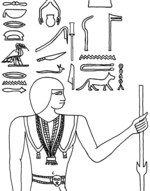
Hotepsekhemwy is the Horus name of an early Egyptian king who was the founder of the Second Dynasty of Egypt. The exact length of his reign is not known; the Turin canon suggests an improbable 95 years while the ancient Egyptian historian Manetho reports that the reign of "Boëthôs" lasted for 38 years. Egyptologists consider both statements to be misinterpretations or exaggerations. They credit Hotepsekhemwy with either a 25- or a 29-year rule.

Huni was an ancient Egyptian king, the last pharaoh of the Third Dynasty of Egypt during the Old Kingdom period. Based on the Turin king list, he is commonly credited with a reign of 24 years, ending c. 2613 BC.

Mentuhotep I may have been a Theban nomarch and independent ruler of Upper Egypt during the early First Intermediate Period. Alternatively, Mentuhotep I may be a fictional figure created during the later Eleventh Dynasty, which rose to prominence under Intef II and Mentuhotep II, playing the role of a founding father.
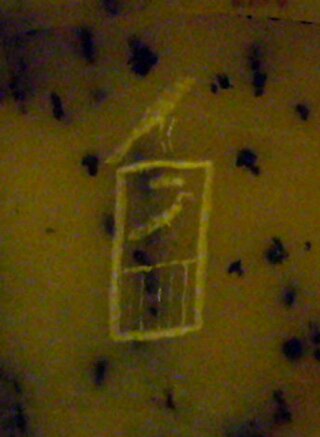
Khaba was a pharaoh of Ancient Egypt, active during the 3rd Dynasty of the Old Kingdom period. The exact time during which Khaba ruled is unknown but may have been around 2670 BC, and almost definitely towards the end of the dynasty.

Nebra or Raneb is the Horus name of the second early Egyptian king of the 2nd Dynasty. The exact length of his reign is unknown since the Turin canon is damaged and the year accounts are lost. Manetho suggests that Nebra's reign lasted 39 years, but Egyptologists question Manetho's view as a misinterpretation or exaggeration of information that was available to him. They credit Nebra with either a 10- or 14-year rule.
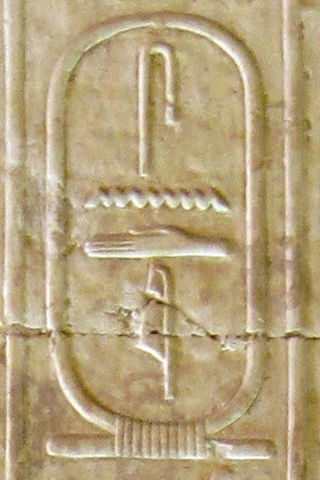
Senedj was an early Egyptian king (pharaoh), who may have ruled during the 2nd Dynasty. His historical standing remains uncertain. His name is included in the kinglists of the Ramesside era, although it is written in different ways: While the Abydos King List imitates the archaic form, the Royal Canon of Turin and the Saqqara King List form the name with the hieroglyphic sign of a plucked goose.
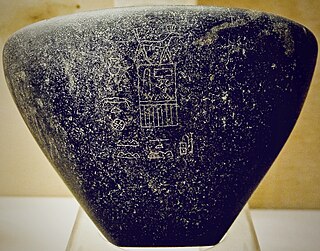
Seth-Peribsen is the serekh name of an early Egyptian monarch (pharaoh), who ruled during the Second Dynasty of Egypt. His chronological position within this dynasty is unknown and it is disputed who ruled both before and after him. The duration of his reign is also unknown.
The royal titulary or royal protocol is the standard naming convention taken by the pharaohs of ancient Egypt. It symbolised worldly power and holy might, also acting as a sort of mission statement for the duration of a monarch's reign.

Sekhemib-Perenma'at, is the Horus name of an early Egyptian king who ruled during the 2nd Dynasty. Similar to his predecessor, successor or co-ruler Seth-Peribsen, Sekhemib is contemporarily well attested in archaeological records, but he does not appear in any posthumous document. The exact length of his reign is unknown and his burial site has yet to be found.
Neferkara I is the cartouche name of a king (pharaoh) who is said to have ruled during the 2nd Dynasty of Ancient Egypt. The exact length of his reign is unknown since the Turin canon lacks the years of rulership and the ancient Egyptian priest Manetho suggests that Neferkara's reign lasted 25 years. Egyptologists evaluate his statement as a misinterpretation or exaggeration.
Hudjefa is an ancient Egyptian word meaning "missing" or "erased". It was used by the royal scribes of the Ramesside era during the Nineteenth Dynasty of Egypt, when the scribes compiled king lists such as the Abydos King List, the royal table of Sakkara and the Royal Canon of Turin when the name of a deceased pharaoh was unreadable, damaged, or completely erased.
Thamphthis is the hellenized name of an ancient Egyptian ruler (pharaoh) of the 4th Dynasty in the Old Kingdom, who may have ruled around 2500 BC under the name Djedefptah for between two and nine years. His original Egyptian name is lost, but it may have been Djedefptah or Ptahdjedef according to William C. Hayes. Thamphthis is one of the shadowy rulers of the Old Kingdom, since he is completely unattested in contemporary sources. For this reason, his historical figure is discussed intensely by historians and Egyptologists.
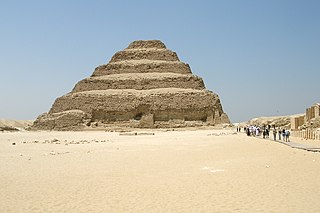
The Third Dynasty of ancient Egypt is the first dynasty of the Old Kingdom. Other dynasties of the Old Kingdom include the Fourth, Fifth and Sixth. The capital during the period of the Old Kingdom was at Memphis.

Neferkasokar was an Ancient Egyptian king (pharaoh) who may have ruled in Egypt during the 2nd Dynasty. Very little is known about him, since no contemporary records about him have been found. Rather his name has been found in later sources.

Wadjenes, also known as Wadjlas, Ougotlas and Tlas, was an early Egyptian king who may have ruled during the 2nd Dynasty. Since the name form "Wadjenes" is not contemporarily attested as the name of a king, but frequently appears in Ramesside kinglists, Egyptologists to this day are trying to connect Wadjenes with contemporary Horus-kings.
Hudjefa is the pseudonym for a 2nd Dynasty pharaoh as reported on the Turin canon, a list of kings written during the reign of Ramses II. Hudjefa is now understood to mean that the name of the king was already missing from the document from which the Turin canon was copied. The length of the reign associated to Hudjefa on the canon is 11 years. Because of the position of Hudjefa on the Turin list, he is sometimes identified with a king Sesochris reported in the Aegyptiaca, a history of Egypt written by the Egyptian priest Manetho in the 3rd century BC. Manetho credits this pharaoh with 48 years of reign. Egyptologists have attempted to relate Hudjefa with archaeologically attested kings of the period, in particular Seth-Peribsen.

Sneferka was an early Egyptian king who may have ruled at the end of the 1st Dynasty. The exact length of his reign is unknown, but thought to have been very short and his chronological position is unclear.

Bikheris is the Hellenized name of an ancient Egyptian pharaoh, who may have ruled during the 4th Dynasty around 2570 BC. Next to nothing is known about this ruler and some Egyptologists even believe him to be fictitious.
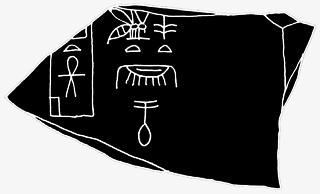
The prenomen, also called cartouche name or throne name of ancient Egypt, was one of the five royal names of pharaohs. The first pharaoh to have a Sedge and Bee name was Den during the First Dynasty.
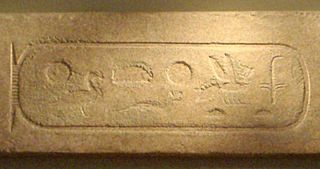
The nomen of ancient Egyptian pharaohs was one of the "great five names". It was introduced by king Djedefre, third pharaoh of the 4th Dynasty, as an emendation to the traditional nswt-bity crest. The nomen was later separated from the prenomen to become an independent royal name.
















